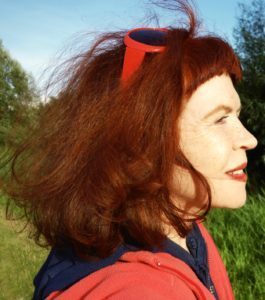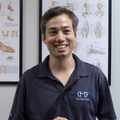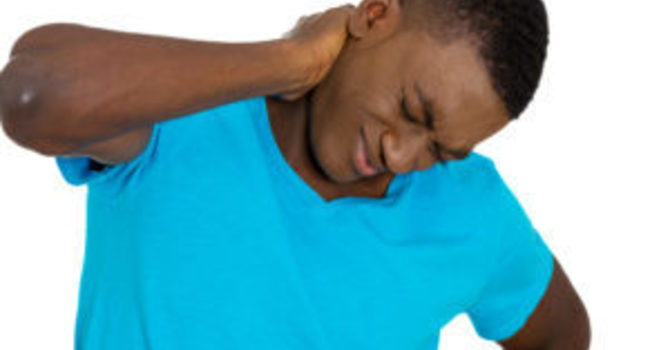
Your jaw, or temporomandibular joint (TMJ), is one of the most highly used articulations in your body. Through coordinated muscular contractions and relaxations it’s involved in chewing, speaking, swallowing, breathing and making emotional facial expressions.
According to Hoppenfield et. al (as cited by Briggs 2013) the TMJ opens and closes an average of 1,500 – 2,000 times per day. Our jaws work much like a pair of tongs, “…the power is applied near the joint, while the work is performed at the opposite extremity of the jaw levers (Scientific America). This allows us to exact about 1,100 – 1,300 Newtons when clamping down with our 2nd molars. To put this in perspective, that’s about 250-292 lbs of bite force (Wroe 2010)! A large part of this bite force is produced by what are considered the strongest muscles in the body by weight, the masseter muscles, otherwise known as your “cheek muscles” along your jaw.
It is not difficult to imagine how such a powerful articulation can cause significant pain and interfere with quality of life, if it is not working properly. The TMJ can become dysfunctional due to injury, stress, malocclusion, neurological disease, and other structural changes such as arthritis. Temporomandibular dysfunction (TMJD) can bring about an array of signs and symptoms, many of which create a feed-forward loop, perpetuating the problem.
The TMJ can refer symptoms to the head and face, neck, upper back, and shoulders. Neck and upper back pain are often driven by TMJD and vice versa (Fink 2003). Although the muscles of mastication (Temporalis, Masseter, Buccinator, Medial pterygoid, Lateral pterygoid, Digastrics, Mylohyoid) are mostly involved with the improper movement of the TMJ, imbalances in the joints and muscles of the neck, back, and shoulders can perpetuate TMJD from afar and are often overlooked. These muscles include:
- Sternocleidomastoid
- Scalenes
- Levator Scapulae
- Trapezius
- Rhomboids
- Infraspinatus
- Supraspinatus
- Latissimus Dorsi
Signs and Symptoms of TMJD
- Clenching – take the time note if you clench your jaw during the day
- Bruxism – grinding your teeth especially at night, while asleep
- Clicking/popping – this often occurs when you open or close your mouth
- Lock/Catch – any sense of locking or catching, instead of a smooth opening and closing
- Deviation from midline – the jaw deviates right or left while opening or closing
- Protruding – the jaw may first protrude forward while opening, instead of moving straight down and in
- Inability to open jaw fully – the jaw should open comfortably enough to allow about 3 fingers breadth between your top and bottom teeth
- Poor Posture – TMJD may cause poor upper body posture, such as forward head posture or poor posture. Poor posture is the reason or the result of TMJD (Nikolakis 2000).
- Tinnitus – ringing in the ear
- Inability to chew – sometimes only one side
- Headaches – TMJD can trigger headaches including: tension, cervicogenic, and migraine
- Face pain – pain along the jaw, ears, cheeks, or eyes
- Neck/upper back pain
Treatment:
In a survey of 192 patients suffering from temporomandibular pain, De Bar et. al. noted the following:
- Two-Thirds of participants used hands-on, conservative care as part of their treatment plan along with traditional medical care.
- The majority reported that hands-on care was modestly helpful to very helpful.
- Those using hands-on care as part of their treatment plan, showed greater re-engagement in physical activity and improved sleep.
Here at the Center for Musculoskeletal Function, we use a hands-on treatment approach designed to help with TMJ dysfunction conservatively. We believe in taking the time to properly evaluate the temporomandibular joint locally and globally, as well as its relation to the kinetic chain, looking for dysfunction in the neck, upper back, and shoulders, so that we can best set a course of treatment. When a team approach is necessary, we are happy to work and communicate with your other providers for best outcomes. We will also coordinate referrals when it is appropriate.
©CenterForMusculoskeletalFunction2018
References
Chiropractic, Dentistry and Treatment of TMD. (2009, October 21). Retrieved from https://www.dynamicchiropractic.com/mpacms/dc/article.php?id=54261
De Bar, L. L., Vuckovic, N., Schneider, J., & Ritenbaugh, C. (n.d.). Use of complementary and alternative medicine for temporomandibular disorders. Journal of Orofacial Pain, 17, 224-36.
Fink, M., Wähling, K., Stiesch-Scholz, M., & Tschernitschek, H. (2003). The Functional Relationship Between the Craniomandibular System, Cervical Spine, and the Sacroiliac Joint: A Preliminary Investigation. CRANIO®, 21(3), 202-208. doi:10.1080/08869634.2003.11746252
Janda, V. (1986). Some aspects of extracranial causes of facial pain. The Journal of Prosthetic Dentistry, 56(4), 484-487. doi:10.1016/0022-3913(86)90394-x
Nicolakis, P., Nicolakis, M., Piehslinger, E., Ebenbichler, G., Vachuda, M., Kirtley, C., & Fialka-Moser, V. (2000). Relationship Between Craniomandibular Disorders and Poor Posture. CRANIO®, 18(2), 106-112. doi:10.1080/08869634.2000.11746121
The Power of the Human Jaw. (n.d.). Retrieved from https://www.scientificamerican.com/article/the-power-of-the-human-jaw/
Some Thoughts on the TMJ. (2013, May 15). Retrieved from https://www.dynamicchiropractic.com/mpacms/dc/article.php?id=56480
Temporomandibular and Orofacial Disorders: A Functional Perspective. (1998, May 31). Retrieved from https://www.dynamicchiropractic.com/mpacms/dc/article.php?id=37241
TMJ and Whiplash: Of Forces and Farces. (1992, April 24). Retrieved from https://www.dynamicchiropractic.com/mpacms/dc/article.php?id=43212
TMJ Syndrome: An Integrative Treatment Approach. (2008, January 1). Retrieved from https://www.dynamicchiropractic.com/mpacms/dc/article.php?id=53017
Wroe, S., Ferrara, T. L., McHenry, C. R., Curnoe, D., & Chamoli, U. (2010). The craniomandibular mechanics of being human. Proceedings of the Royal Society B: Biological Sciences, 277(1700), 3579-3586. doi:10.1098/rspb.2010.0509








